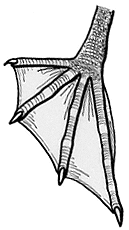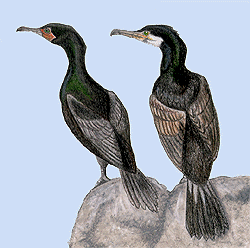Cormorants & Gannets
Order Pelicaniformes including the Families:
Sulidae (gannets) and the Phalacrocoracidae (cormorants)

Left foot of a cormorant;
note all four toes webbed
The taxonomic Order of the Pelicaniformes includes the namesake, the pelican. This very diverse group of related birds share, to differing extents, a few characteristics including: a flexible throat flap or “gular pouch” webbing between all four toes and a marine or aquatic range. Despite their relatedness, different habitats have produced widely differing variations on a similar theme: the coastal, diving brown pelican, the soaring, piratical frigate bird or the submersible cormorants to name a few. The Order includes about 50 species scattered across the globe.
On Stellwagen Bank, only three species are seen with any regularity including the Northern gannet and great and double-crested cormorants. All are truly water birds with the cormorants hugging the shallow coasts and the gannets soaring the high seas.
Northern gannets, Morus bassanus, are the largest sea bird in our area with a wingspan of over 170 cm (6 feet). Their long, pointed design and keen eye sight gives them speed and superb diving ability; perfect for a bird that has to cover large distances in search of schooling fish.
Unlike most birds, the eyes of a gannet are placed forward on the face and may create a stereoscopic image of the watery habitats passing below. When hunting gannets find a school of fish (often sand lance or herring on Stellwagen) they fold back their long, pointed

The long pointed, black-tipped wings of an adult gannet; head pointed down while hunting
wings and drop, sometimes from 12 meters (40 feet), from the air to the water below. Air pockets about the skull and neck cushion the blow as the bird enters the water. Once underwater, gannets grab at the frightened fish with their long bills and bob back to the surface to swallow their meal and take a brief rest.
Like many pelagic birds, gannets spend most of their time out at sea. They do come ashore to nest though for a brief summer season. Gannets nest in noisy, cramped colonies on remote, rocky islands further north in the North Atlantic. Adult birds are commonest in our area during the non-breeding months as they wander south in search of feeding grounds. Newly fledged young leave their nesting islands in late summer and may not touch land for another four or five years, wandering the seas as they mature. These mottled brown, immature birds may be spotted on the Bank at any season whereas the bright white adults become most numerous in spring and, again in late fall.

Note the orange throat pouch of the double-
crested cormorant and the white of the
great cormorant
Cormorants have entirely different habitat needs than the gannets despite the fact that both feed on small fish, sometimes of the same species. With broad, rounded wings, the flight of the cormorant is more labored and less dependent upon soaring. Their heavy bodies, long flexible necks, broad, webbed feet and long, hooked bills are superb for underwater pursuit: cormorants swim for a living. Large sensitive eyes for gathering light in murky water combined with quick reflexes allow cormorants to take advantage of food sources too deep for most other sea birds.
From the surface, cormorants often make a quick, head first jump as they submerge. Paddling with wings and feet, they quickly gain depth. Good eye-beak coordination allows them to chase down even the quickest of fish while the claw-like extension of the bill. Unlike most water birds, cormorants do not evenly coat their feathers with oil (from their oil glands) for insulation. This allows water to soak into the feathers and decreasing buoyancy; cormorants sink like stones.
The great cormorant, Phalacrocorax carbo, are large cormorants (90 cm or 36 inches) with a wide distribution across the temperate zones. In the North Atlantic they breed from the coast of Maine north and east to Europe and winter more to the south, along the northeast coast to the mid-Atlantic states. Great cormorants arrive in our area during October, with highest numbers in mid-December to March.
Like the double-crested cormorants, these cormorants are relatively coastal birds and often rest or roost on piers, breakwaters and small islands. Loose bands or individuals fan out over suitable hunting areas especially shallow, protected bays. When migrating they form ragged lines that fly low on the water. Cormorants seen in winter in our area are likely to be greats as double-cresteds generally move further south. If they are found together (especially in fall) the great can be distinguished from the double-crested, in flight, by their straighter neck and more massive head. Perched, the white cheek and throat patch of the great may be visible.
Double-crested cormorants, Phalacrocorax auritus (83 cm or 33 inches), are a truly North American species that ranges from fresh water lakes to the coasts. In our area they are an abundant coastal resident between April and November, nesting in loose colonies on protected islands and breakwaters. Winters are spent further south and bands of migrating birds may be seen over the Bank.
Rarely found far from shore, double-crested cormorants are most often seen by whale-watchers while leaving the harbor. Hunting about the pilings for fish like herring and young cod, or perched on rocks, they are an obvious and welcome sight. To dry their waterlogged feathers, they haul out wings outstretched and face the sun. In all seasons, some orange on the gullar pouch distinguishes them from the great cormorant. In summer, breeding plumes above the eyes sprout out, beyond the back of the head.

Our Work
Humpback Whale Research
Right Whale Research
Marine Animal Entanglement Response
Marine Geology Department
Water Quality Monitoring Program
Marine Fisheries Research
Seal Research
Shark Research
Marine Education
Interdisciplinary
Marine Debris and Plastics Program
Marine Policy Initiative
Cape Cod Climate Change Collaborative
Publications

